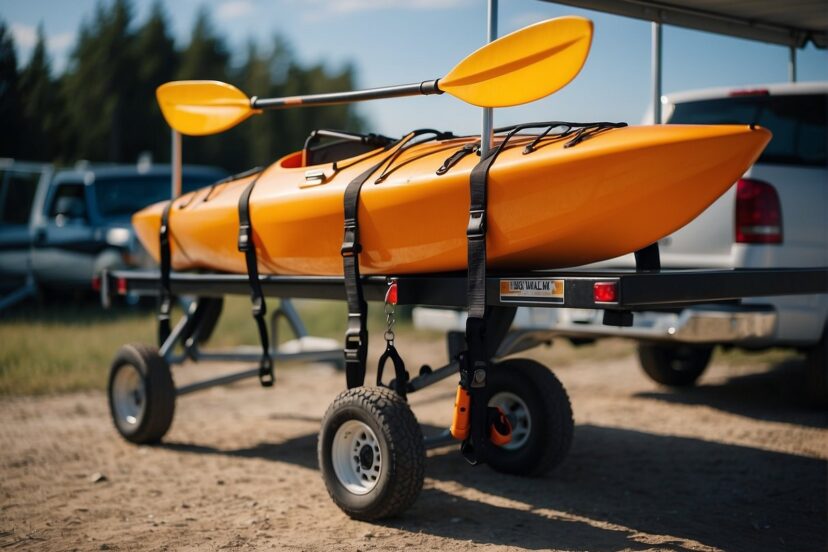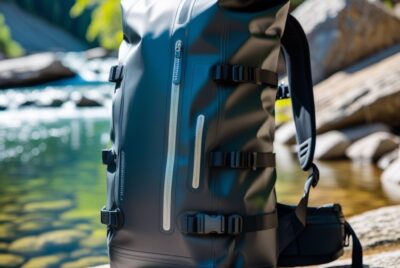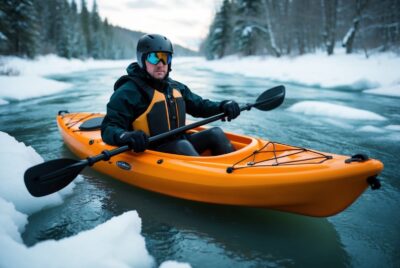Kayak Rack for Trailer: Maximizing Space and Protecting Your Gear
*We may earn a commission for purchases made using our links. Please see our disclosure to learn more.
Kayak Rack for Trailer: Maximizing Space and Protecting Your Gear
When it comes to transporting kayaks, a good kayak rack for a trailer is essential for convenience and safety. In my experience, having a reliable rack system not only makes it easier to load and unload kayaks but also ensures they stay secure during transit. The types of racks available on the market vary greatly, with options to fit different trailer sizes, kayaking needs, and price points.

I’ve discovered that choosing the right kayak rack for a trailer revolves around several key considerations. The construction material, durability, ease of use, and the number of kayaks that need to be transported are critical factors. Having had the opportunity to compare various racks, including J-style, V-style, and saddles, I’ve found that each design offers unique benefits tailored to specific requirements and vehicle types.
My research also indicates that customer reviews and ratings provide valuable insight into the practicality and longevity of kayak racks. Access to a wide selection of racks on platforms like Amazon or specialized retailers helps me scrutinize different models and brands. This, combined with understanding the features such as mount types and carrying capacities, equips me to make an informed decision on the best kayak rack to fit my trailer for any adventure.
Choosing the Right Kayak Rack for Your Trailer

When outfitting my trailer with a kayak rack, I focus on ensuring the durability, stability, and compatibility of the rack with my kayaks and trailer. Here’s how I choose the right one.
Considerations for Kayak Trailers
Before selecting a rack, I consider how frequently I’ll be transporting kayaks, the types of kayaks I own, whether I’ll need to carry canoes or paddle boards, and the distance of my trips. For example, I opt for more robust racks if I’m transporting heavy fishing kayaks or several traditional kayaks at once.
Selecting the Material
I prioritize materials based on their durability and resistance to the elements. My options typically include:
- Steel: Offers high durability, often less expensive.
- Aluminum: Lightweight, resistant to corrosion, better for fuel economy.
- Galvanized Steel: Combines durability with excellent corrosion resistance, ideal for use in saltwater environments.
Selecting the Style of Kayak Racks
I choose a style based on my specific needs:
- J-Style: Saves space, allows for easy loading.
- Saddle-Style: Provides stability, easy to secure the kayak.
- Vertical Kayak Rack: Best for when I need to transport multiple kayaks.
- Folding: Ideal if I need to reduce the rack’s profile when not in use.
Weight Capacity and Dimensions
I ensure that the rack’s weight capacity exceeds the combined weight of my kayaks. Typical racks support up to 250 lbs or more. It’s also critical to confirm that my kayak trailer can accommodate the full length of my kayaks, up to 20 feet long, without overhang that could pose safety risks or contravene road regulations.
Installation and Compatibility

Selecting the proper kayak rack for a trailer involves ensuring compatibility with both the trailer and the kayak, as well as considering ease of installation. The specific design of the rack should match the type of bars present on the roof of the trailer if applicable, or be appropriately sized and shaped to attach to the trailer hitch.
Mounting Options for Roof and Trailer Hitch
- For vehicles equipped with factory-installed bars, crossbar styles such as round, square, elliptical, and aero bars can be accommodated by various rack systems from brands like Rhino-Rack, Yakima, and Malone.
- Saddle-style carriers are a common choice and typically involve a four-point system that cradles the kayak for transport.
Trailer Hitch Options:
- For those using a camper or RV, hitch-mounted racks are an excellent alternative. They require a standard 2-inch hitch receiver.
- RV kayak racks tend to hold kayaks vertically and are an efficient use of space.
Installation Methods:
- Roof racks often use a clamp-on system for vehicles with existing crossbars. Installation tools are usually provided.
- Hitch-mounted racks may require more substantial assembly but generally come with clear instructions and can be installed with basic tools.
Load Assist and Accessibility Features
Load Assist:
- Some roof racks come with load assist features to help elevate the kayak onto the roof, which is especially helpful if the trailer is tall.
- I can confirm that options without load assist may require two people to safely place the kayak on the rack.
Accessibility:
- Hitch-mounted racks generally make loading and unloading easier since the kayak does not have to be lifted as high.
- Features such as tilting mechanisms or extendable arms can aid accessibility, making the use of the rack more convenient.
It’s important to consider the kayak’s dimensions and weight when evaluating these options to ensure they meet the specific needs of the trailer or vehicle in question. Proper installation secures the kayak for travel and optimizes accessibility for a hassle-free experience.
Safe Transport of Kayaks and Canoes

When transporting kayaks and canoes, securing your watercraft properly and adhering to safety and regulatory standards are essential. I’ll provide tips to ensure your gear arrives safely and legally at your destination.
Securing Your Watercraft
To safely transport kayaks or canoes on a trailer, I use cradles that conform to the hull’s design, providing a stable base. It is important to use tie-down straps to secure the craft both fore and aft. Here’s how I do it:
- Place the kayak or canoe on the cradles ensuring even weight distribution.
- Use ratchet straps for a secure fit, avoiding over-tightening to prevent hull damage.
- Padding under the straps can prevent scratches and improve grip.
- Ensure that the tie-downs do not obstruct the trailer’s turn signals or brake lights.
- Double-check that the ball hitch is secure and that the jack is raised before driving.
Safety and Regulatory Considerations
- Reflectors and Lights: The trailer must have working taillights, and I always check that the turn signals and brake lights are synchronized with the towing vehicle.
- Tie-Downs: In addition to ratchet straps, I use bow and stern tie-downs for additional security.
- Visibility: I make sure the watercraft doesn’t obscure the vehicle’s number plate or lights.
- Legal Compliance: I check local regulations regarding the transportation of overhanging loads to avoid penalties.
Additional Accessories and Maintenance

When considering the addition of a kayak rack to a trailer, it’s not just about the rack itself. I find it crucial to also think about how accessories and maintenance play a part in enhancing the functionality and longevity of your transport solution.
Kayak Storage and Cargo Solutions
To maximize my trailer’s potential, I often incorporate a combination of storage and cargo accessories. The aim here is to enable efficient transportation of a kayak along with related gear while protecting my equipment from damage during transit.
- Ladder Racks / Rhino-Rack: Rhino-Rack’s ladder racks are versatile, and, in my experience, they can be used to carry kayaks as well as ladders. I usually recommend Rhino-Rack products due to their build quality and functionality.
- Malone TopTier Load Bar Kit: Consisting of crossbars (often coming in sets such as qty 2), this kit allows me to carry kayaks above my trailer. This is quite useful when I need to free-up space for additional cargo on the trailer bed.
- Clamp-on and Bolt-on Accessories: Accessories that I can clamp or bolt onto my trailer’s frame, like saddle-style carriers or mounts, are invaluable. They generally offer a secure fit for the kayak, and I appreciate the added stability they provide, especially when I’m transporting fishing kayaks, which tend to be bulkier.
- Trailers Cargo Organizers: I always strive to keep my gear organized. Cargo organizers can be critical for keeping paddles, life jackets, and other accessories secured and easily accessible.
- Kayak Storage Rack—MPG493: A good kayak storage rack, such as the MPG493, will protect my kayak from scratches and dents. These racks are specially designed to cradle and secure my kayak during transport.
- S510 / S512-S512X: For paddle or surfboard transport solutions, I consider accessories like the S510 or the S512-S512X. These are designed to securely carry more elongated sports equipment alongside my kayak.
Maintenance of these accessories is also key. Regular checks and following up with any necessary repairs or adjustments ensure that everything remains in excellent condition. Bolt-on installations usually need periodic tightening, and I always inspect straps and tie-downs for wear and tear.
In summary, my approach to additional accessories and kayak maintenance on a trailer involves a careful selection of reliable components and a dedicated maintenance routine to ensure each journey is as smooth as the last.
Expert Tips and Recommendations

In my experience, the effectiveness of kayak transportation on trailers depends largely on the organization and secure attachment of the kayaks. Addressing space concerns and common issues beforehand can make the process much smoother.
Maximizing Space and Efficiency
For recreation enthusiasts and professionals in contracting or landscaping, space on a trailer is critical. Pros know that using a T-style rack can save substantial space, allowing for additional equipment or kayaks on the trailer. When dealing with motorhomes or RVers, height clearance is a top consideration. My recommendation is to opt for a design that doesn’t elevate kayaks too high to avoid clearance issues. For example, a folding J-style rack can be a great space-saving solution that’s also efficient.
- Pro tip for maximizing trailer space:
- Use vertical racks like the Malone MicroSport Trailer when transporting multiple kayaks.
- Invest in a bumper-mounted rack for easy loading and unloading.
Addressing Common Concerns
One common question I encounter is how to transport kayaks without causing damage. A proper kayak rack for trailers should include padding to protect the kayak’s surface; ladder racks are often an excellent solution for this. When loading fat bikes or other large items alongside kayaks, ensure the kayak is snug and secure to prevent movement. Racks like the Malone MicroSport Trailer often have the versatility to accommodate such items without fuss.
Another significant concern is ease of access. For those who find lifting a kayak problematic, especially with higher RVs or motorhomes, consider a rack with a lowering mechanism like the Thule Hullavator Pro.
- Effective solutions to common concerns:
- Use high-quality straps and tie-downs for securing kayaks.
- Ensure the rack is compatible with your trailer’s design—etrailer offers a range of options suited for different needs.
By following these tips and recommendations, I’ve found that transporting kayaks can be a stress-free aspect of gearing up for an adventure or completing a job.
Frequently Asked Questions
When considering a kayak rack for your trailer, it’s essential to understand the benefits, method selection, installation, travel speeds, and the necessity of the kayak rack to ensure a safe and efficient transport experience.
1. What are the benefits of using a kayak rack on your trailer?
A kayak rack on your trailer provides secure transport, allowing for stable positioning and mitigation of damage to the kayak. It also frees up space within the trailer or vehicle for other gear or passengers.
2. How do you choose the best kayak rack for your trailer?
Selecting the best kayak rack for your trailer involves considering your specific needs, such as the number of kayaks, kayak sizes, and the compatibility with your trailer. Assessing the rack’s weight capacity, durability, and ease of loading and unloading is also crucial.
3. What are some creative kayak trailer rack ideas to maximize space?
To maximize space, consider vertical racks or stacker designs that allow kayaks to be transported on their sides, or racks that enable multiple kayaks to be carried on different levels or using J-style carriers.
4. How do you securely install a removable kayak rack on a trailer?
Secure a removable kayak rack on a trailer by following the manufacturer’s instructions for attachment points and locking mechanisms. Ensure that the rack is firmly in place with no movement before loading kayaks.
5. Is it necessary to invest in a kayak rack for a trailer or can kayaks be transported safely without one?
While it’s possible to transport kayaks without a rack using padding and careful strapping, investing in a kayak rack for a trailer is recommended for the added security and stability, especially for frequent transport or longer distances.




